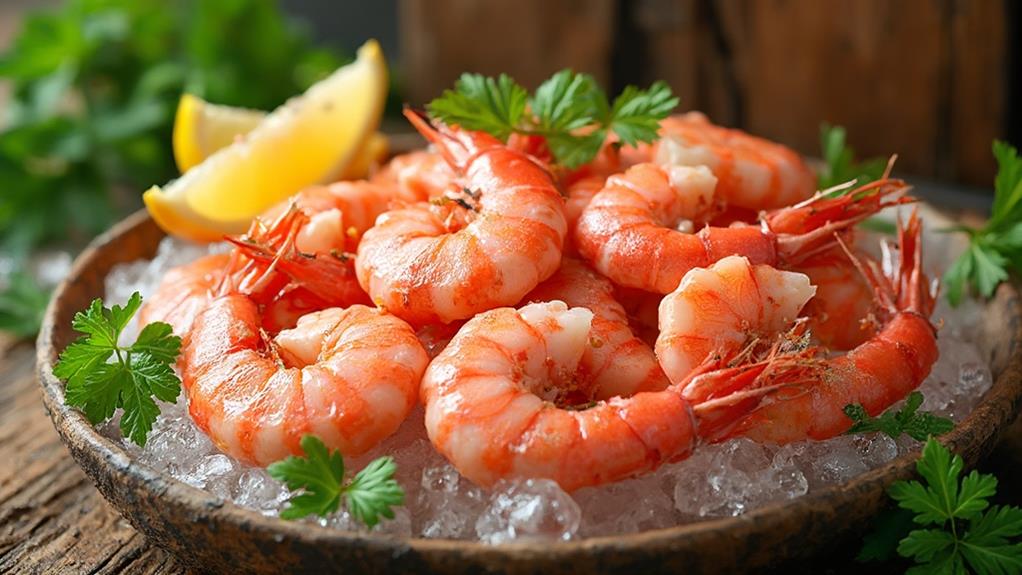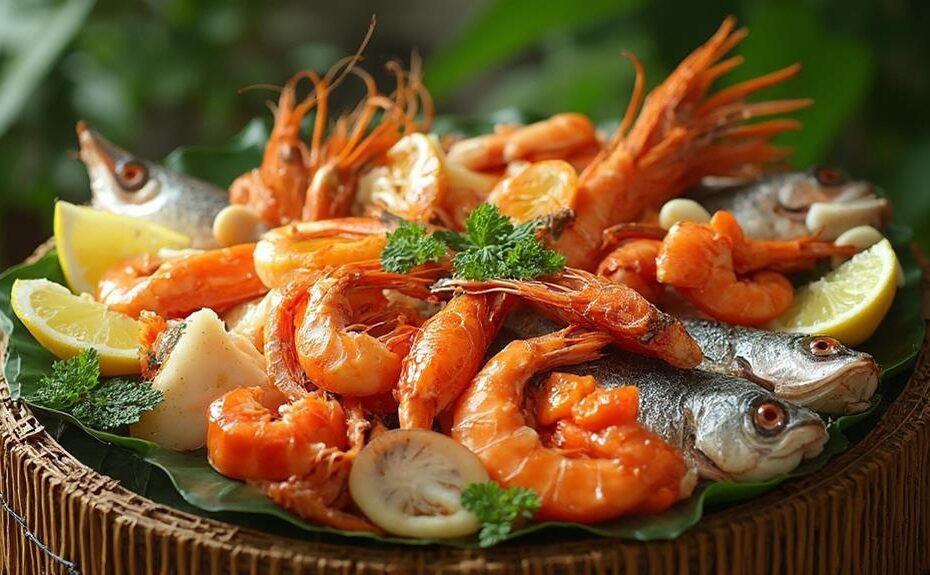Filipino seafood is an excellent source of omega-3 fatty acids, essential for overall health. These fatty acids support heart and brain function, making them a crucial part of a healthy diet.
Bangus, tuna, and sardines are rich in omega-3s, with bangus providing around 20 grams of protein per serving while being low in calories.
Sardines not only offer omega-3s but also aid in muscle repair with their high protein content. Although shrimp has lower omega-3 levels, it still contributes valuable nutrients and protein.
To maximize the benefits of these seafood choices, cooking methods play a crucial role.
Overview of Omega-3 Fatty Acids
Omega-3 fatty acids play a crucial role in maintaining overall health. These essential fats, particularly EPA and DHA, are known for their anti-inflammatory properties and their ability to support cardiovascular health.
They can help reduce triglyceride levels, lower blood pressure, and decrease the risk of heart disease.
Filipino seafood is a rich source of omega-3 fatty acids. Varieties such as bangus (milkfish) and sardines are abundant in these beneficial fats.
Incorporating these varieties into your diet can help meet your omega-3 needs.
Omega-3 fatty acids are integral to brain structure and function. Research has shown that adequate intake of omega-3s is linked to improved brain function and mental health.
They contribute to cognitive development and potentially reduce the risk of neurodegenerative diseases.
Omega-3s are vital during pregnancy, supporting fetal brain development. Regular consumption of omega-3-rich seafood not only enhances your nutritional profile but also promotes overall well-being.
By prioritizing these foods, you're making a positive impact on both your health and your palate.
Key Filipino Seafood Varieties
Filipino Seafood Varieties: Rich in Omega-3 Fatty Acids
Filipino seafood varieties aren't only flavorful but also packed with omega-3 fatty acids, which are essential for heart health, brain function, and reducing inflammation.
Bangus (Milkfish): A Staple with Omega-3 Benefits
Bangus, a popular fish in Filipino cuisine, is an excellent source of omega-3s. Its versatility makes it ideal for grilling, frying, or stewing, and it provides a healthy dose of omega-3s in every serving.
Tuna: Rich in Omega-3s and Flavor
Tuna is an excellent source of omega-3 fatty acids, making it a favorite for sashimi and various dishes. Whether enjoyed fresh or canned, tuna provides substantial health benefits due to its high omega-3 content.
Mackerel: Oily Flesh with Omega-3 Benefits
Mackerel is known for its rich, oily flesh, which is rich in omega-3s. Grilling or smoking enhances its flavor, making it a delicious and nutritious option.
Incorporating these seafood varieties into your diet can significantly contribute to your overall health, ensuring you benefit from the essential nutrients they provide.
Nutritional Profile of Bangus

Bangus, a Nutrient-Rich Food Option
Bangus, also known as milkfish, is a nutritionally rich food that provides numerous health benefits. A 100-gram serving of bangus contains approximately 20 grams of protein, making it an excellent source for muscle repair and growth.
Rich in Omega-3 Fatty Acids and Vitamins
Bangus is a significant source of omega-3 fatty acids, which are crucial for heart health and cognitive function. These healthy fats help reduce inflammation and may lower the risk of chronic diseases.
Additionally, bangus contains vitamin B12, selenium, and phosphorus, which support metabolism, immune function, and bone health.
Low in Calories, High in Satiety
With only around 130 calories per serving, bangus is a suitable option for those monitoring their caloric intake. Its lean protein and healthy fat content contribute to satiety, helping you feel full longer.
Health Benefits of Sardines
Sardines are a nutrient-dense food that offers numerous health benefits when incorporated into your diet.
1. Reduces Inflammation and Supports Heart Health: Sardines are an excellent source of omega-3 fatty acids, which play a crucial role in reducing inflammation and supporting heart health.
Regular consumption can lower the risk of heart disease and improve cholesterol levels.
2. Promotes Muscle Growth and Repair: With a high protein content, sardines help in muscle repair and growth.
They provide essential amino acids necessary for maintaining lean body mass, making them an ideal choice for active individuals.
3. Essential for Bone Health, Energy, and Immune Function: Sardines are packed with vitamins and minerals, including vitamins B12 and D, along with important minerals like calcium and selenium.
These nutrients are vital for bone health, energy production, and immune function, ensuring you stay healthy and energized.
How can the high sodium and fat content in certain Filipino dishes affect the nutritional value of seafood rich in omega-3 fatty acids?
The high sodium and fat content in certain Filipino dishes can raise health concerns in filipino dishes. These ingredients can negatively affect the nutritional value of seafood high in omega-3 fatty acids. Consuming these dishes in excess can contribute to heart problems and other health issues related to high sodium and fat intake.
The Role of Shrimp

Shrimp is a nutrient-dense food that offers numerous health benefits due to its impressive nutritional profile.
Shrimp is an excellent source of protein, providing 24 grams per 100 grams, which supports muscle growth and repair. Additionally, it's low in calories, with only around 85 calories per serving, making it an ideal choice for those watching their weight.
Shrimp is a rich source of omega-3 fatty acids, which contribute to heart health. While its omega-3 content is lower than some fatty fish, it still helps reduce inflammation and lower blood pressure.
Shrimp is rich in essential nutrients, including selenium, vitamin B12, and iodine, which are crucial for metabolic processes and overall health.
Furthermore, shrimp contains astaxanthin, a powerful antioxidant that may help protect against oxidative stress.
Incorporating shrimp into your meals provides both culinary flexibility and nutritional benefits. By consuming shrimp, you not only enjoy its delicious taste but also reap its numerous health benefits, making it a valuable addition to your seafood choices.
Cooking Methods to Retain Nutrients
Retaining Nutrients in Seafood Cooking
When cooking seafood, it's essential to choose methods that preserve its nutritional value while enhancing flavor.
Omega-3 fatty acids, found in Filipino seafood, are particularly susceptible to degradation during cooking. To avoid nutrient loss, consider the following three effective cooking methods:
Steaming is a low-water, low-heat method that cooks seafood evenly without leaching out nutrients. This technique retains omega-3 fatty acids and ensures a tender texture.
Poaching involves gently cooking seafood in simmering liquid, like broth or wine, to maintain moisture and flavor. This technique minimizes nutrient loss and keeps the dish light and healthy.
Grilling, when done correctly, enhances the natural flavors of seafood without excessive oil or frying. To avoid degrading beneficial compounds, use moderate heat to prevent charring.
Incorporating Seafood Into Your Diet

Incorporating seafood into your diet can significantly enhance your nutritional intake, offering a rich source of protein, vitamins, and essential fatty acids.
Consuming seafood regularly can improve heart health, cognitive function, and reduce inflammation due to its high omega-3 fatty acid content.
To get started, aim to include seafood in your meals at least twice a week. Choose a variety of options, such as fish, shrimp, and squid, to benefit from different nutrient profiles.
Fatty fish like sardines and mackerel are particularly high in omega-3s, while shellfish can provide important minerals like zinc and selenium.
When selecting seafood, opt for sustainably sourced options to support environmental health.
Cooking methods matter too – grilling, steaming, or baking can help retain nutrients while minimizing added fats.
Pair seafood with fresh vegetables or whole grains for a balanced meal. For instance, a quinoa salad topped with grilled shrimp or fish can be both nutritious and satisfying.
